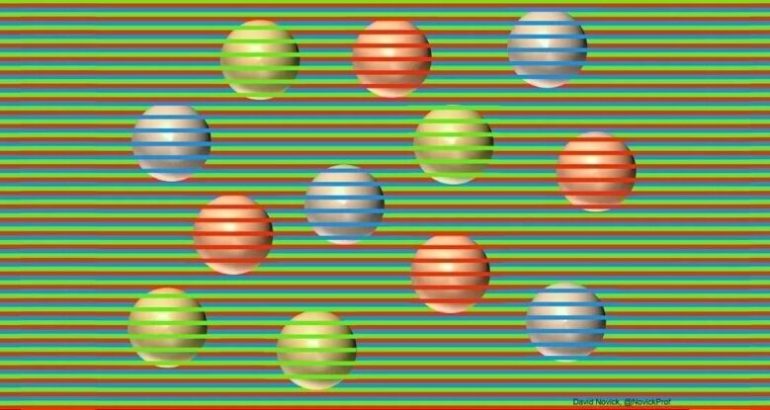These levitating spheres may appear red, purple or green at first glance, but in actuality, all 12 orbs are the same bland shade of beige.
Shrinking the image exaggerates this illusion, while zooming in minimizes the effect, according to David Novick, the creator of the image and a professor of engineering education and leadership at the University of Texas at El Paso.
But why do we perceive the spheres as anything but their true color, beige?
This skewed perception stems from a phenomenon known as the Munker-White illusion, Novick told Live Science.
In essence, the illusion works because “our acuity for shape is better than our acuity for color, which means that we perceive the shapes with more detail and the colors with less detail,” Novick said.
So, while the outlines of the spheres all appear identical, as they are, “the color sort of bleeds over, or assimilates, to adjacent spaces,” Novick said.
Specifically, the color of the spheres gets “pulled” closer to the color of the stripes crossing over them, in the foreground. In this particular image, called “Confetti Spheres 5,” an array of green, red and blue stripes cut across the spheres and warp our perception of their actual hue.
The illusion relies on the hue of the foreground stripes, not the colors in the background behind the spheres. So, if you remove the crisscrossing stripes, the illusion disappears, leaving only identical beige balls.
Your image, with all colours whose Lab color distance from (RGB) #f5c882 is in the 20th percentile or greater, replaced by #ffffff. pic.twitter.com/3iSN8P2ZEE
— Jon Seymour (@jonseymour) June 15, 2019
The illusion works very similarly when you convert all of the colors to grayscale. In fact, “White’s illusion,” in isolation, refers to the perceived changes in the lightness of a shape – ranging from white to black – caused by the lightness of shapes overlapping it, according to a 2010 report published in the journal Colour: Design & Creativity.
For instance, when you run white stripes over a gray rectangle, the gray appears lighter, or closer to white; but when you run black stripes over the same rectangle, it appears darker, or closer to black.
Psychologist Michael White became known for describing this effect in the 1960s. And in 1970, Hans Munker, another psychologist, demonstrated a similar effect with colored shapes and stripes, in which the foreground stripes warp the perceived hue of the background shape, according to the 2010 report.
Scientists have competing theories about what’s happening in the brain to cause this shift in perception. Some think the illusion sets in early during visual processing, when light first hits the retina, while others think the effect takes hold later as the brain processes the data. It could be a combination of both, the 2010 report notes.
Whatever the exact cause of the illusion, it’s fun to play with, Novick said. By tampering with both the lightness and the color of the foreground stripes, you can “amplify” the apparent color change, causing the background shapes to look wildly different from their true colors.
That said, “it’s much easier to get differences in apparent colors for some hues than others,” Novick noted. For instance, if the background shape and foreground stripes are complementary colors (opposites on the color wheel), like red and green, their colors will actually cancel out, so the spheres will end up looking white or grey instead, he said.
Novick is currently studying which color combinations generate the largest apparent change in the color of the background shape to maximize the effects of the illusion.
In addition, he and his collaborator Akiyoshi Kitaoka, a psychology professor at Ritsumeikan University in Kyoto, Japan, are comparing how the Munker-White illusion affects 3D shapes, as in “Confetti Spheres 5,” as compared to flat, 2D shapes.
(David Novick)
Above: This image, called “Confetti 1,” demonstrates how the Munker-White illusion works on 2D shapes.
“The illusion seems more perceptible, or vivid, with the spheres rather than the flat discs. And we don’t know why,” Novick said. “At this point, I don’t think anybody does.”
Novick was originally inspired to craft illusions after seeing and reading about Kitaoka’s work. Kitaoka’s website dances with vivid patterns that appear to swirl and undulate as you stare at them; text along the top of the page warns, “Should you feel dizzy, you had better leave this page immediately.”
Upon studying these baffling illusions, Novick became interested in folding them into his own research program on human-computer interaction.
In summer 2017, he began crafting new versions of the illusions on his own and, for fun, posted some to his Twitter account. One of these posts – a 2D version of the confetti illusion – went “unexpectedly viral” on July 18, 2018.
“I first learned about this when my wife came in and said, ‘You’re in the newspaper in England,'” Novick said, noting his surprise.
To this day, Novick tweets about two new illusions each week, and his older posts periodically get rediscovered, go viral and sometimes make the news, he said.



